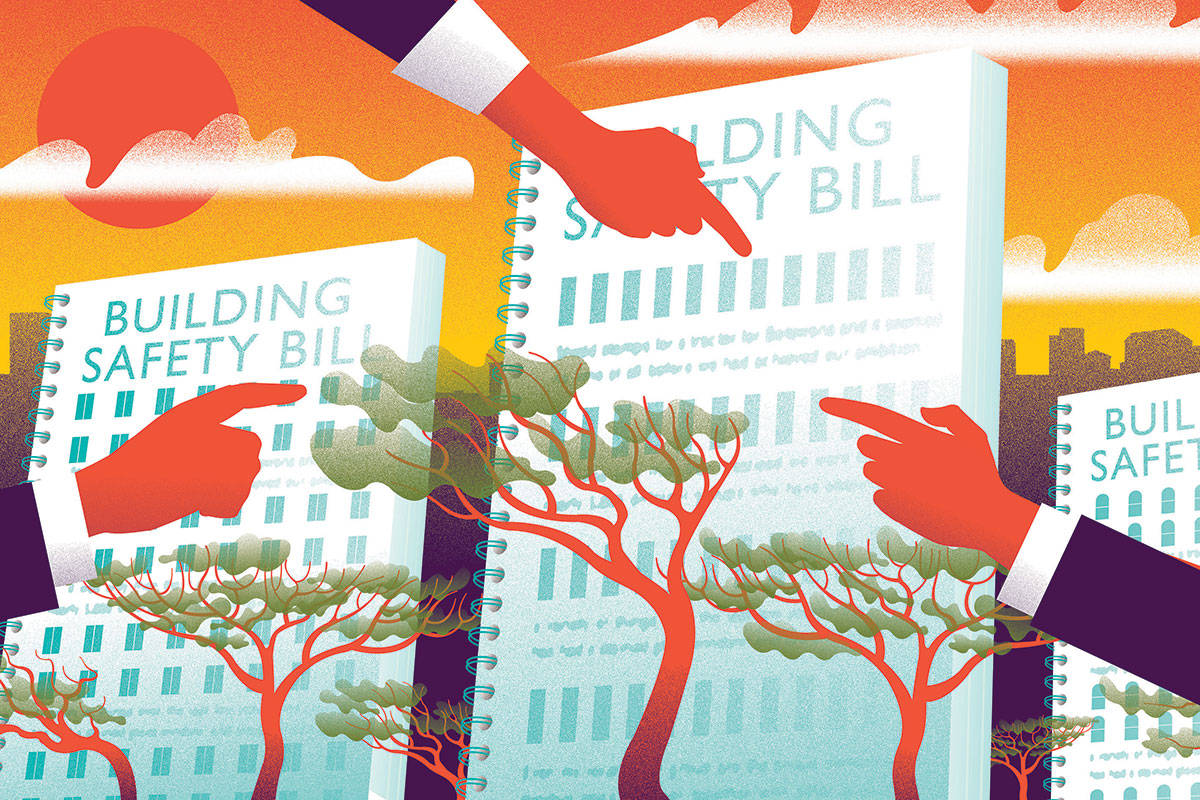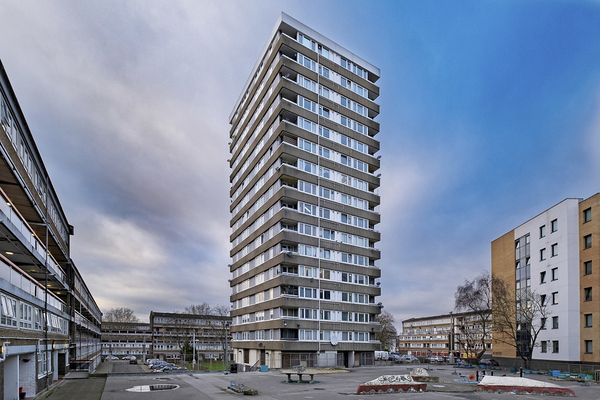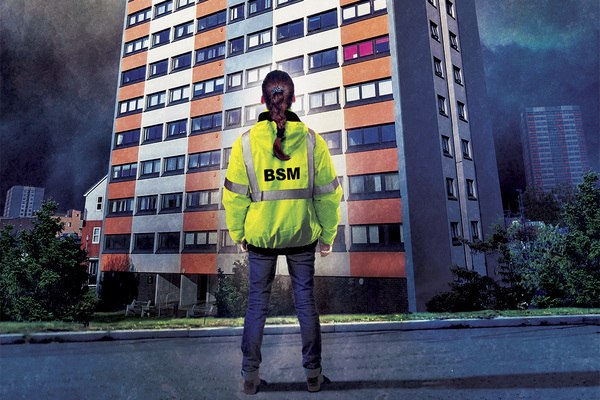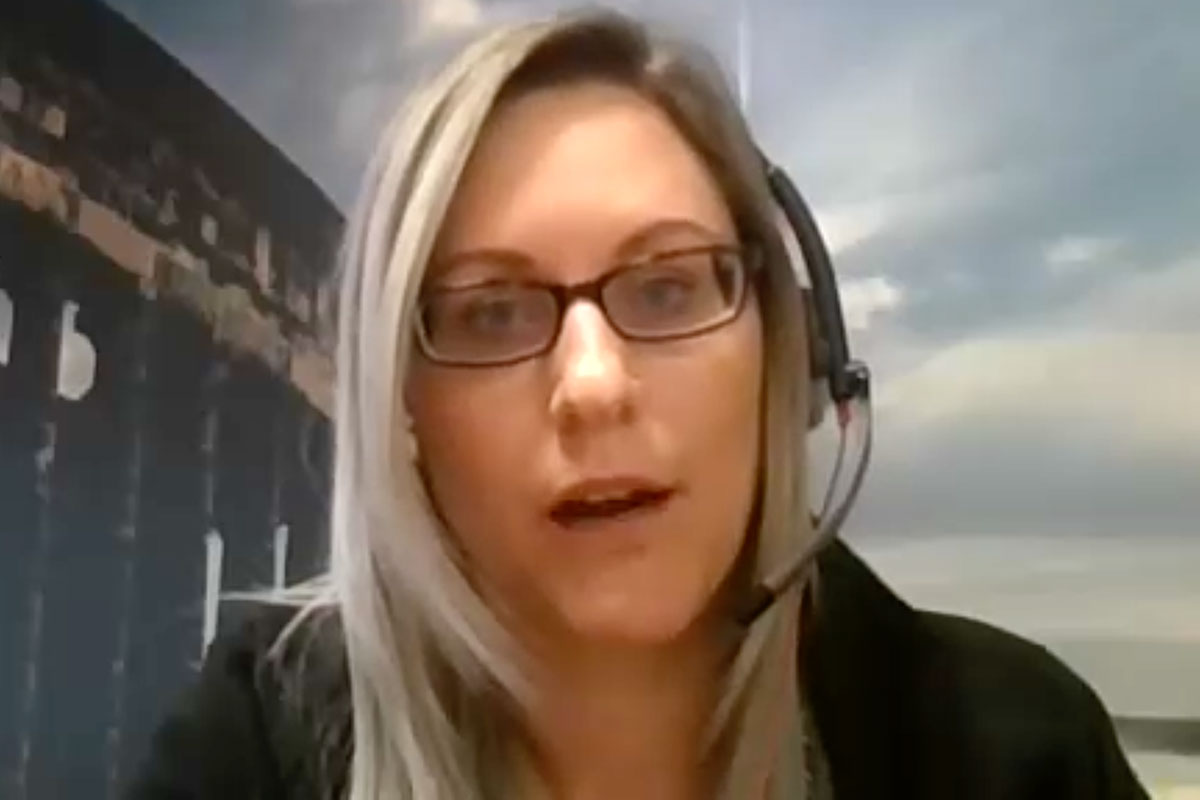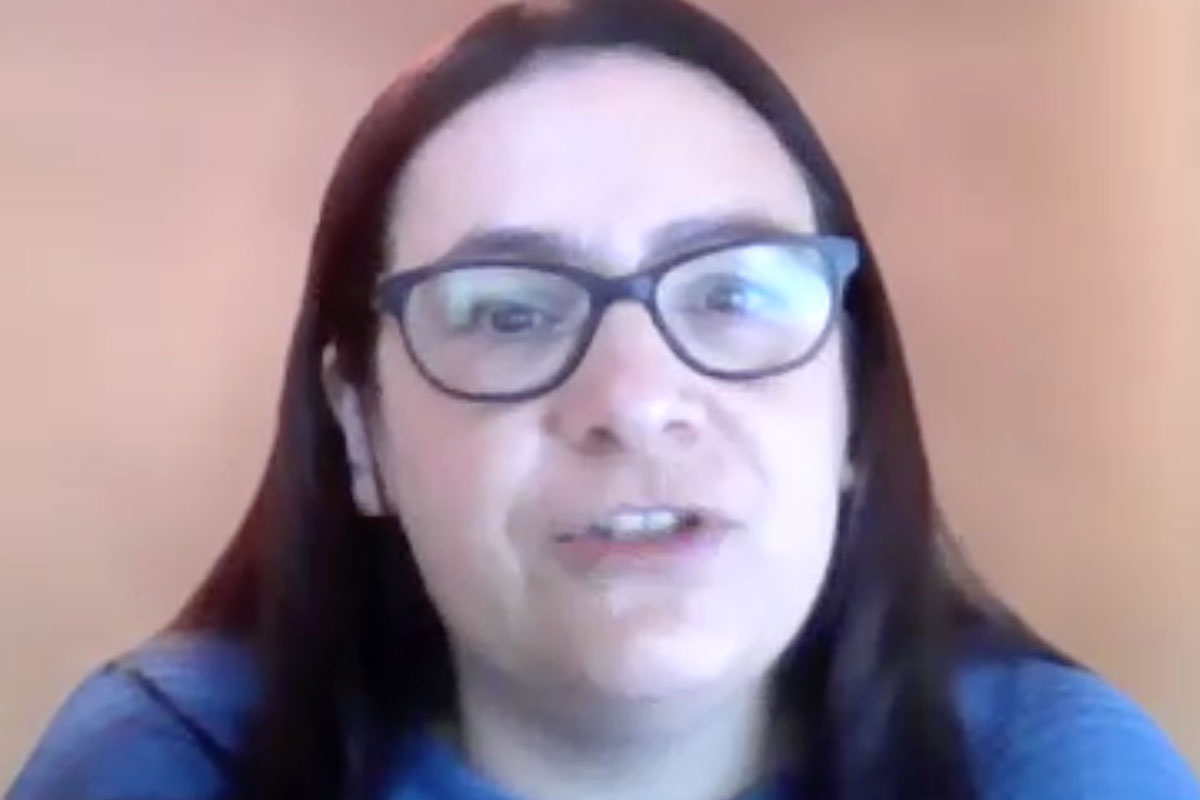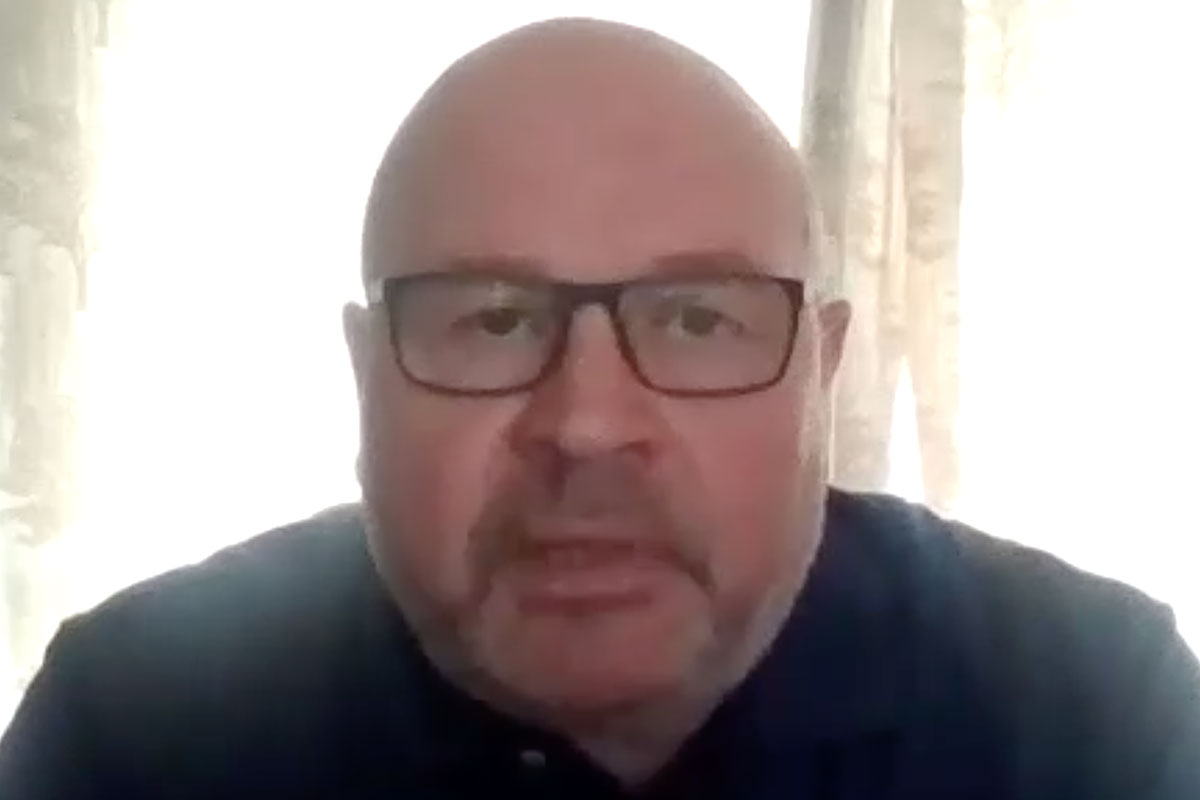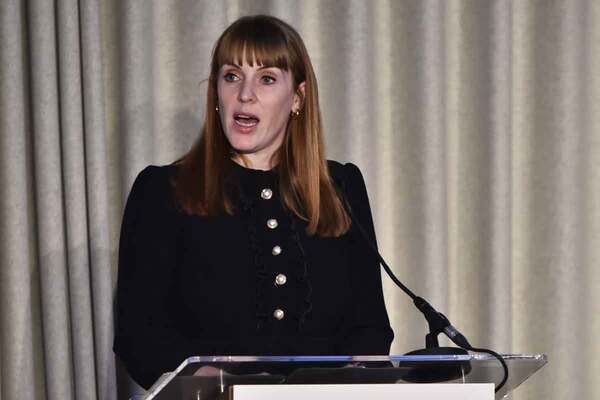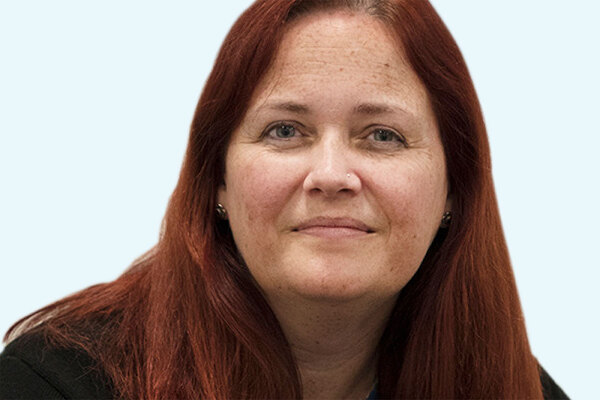What do the recent amendments to the Building Safety Bill mean for compliance responsibilities?
Inside Housing and Anthony Collins Solicitors gathered together sector experts to discuss what scrapping the requirement for building safety managers will mean for managing safety. Illustration by Neil Webb
In association with:
![]()
“Today’s event really couldn’t be more timely,” says Inside Housing’s editor Martin Hilditch, as he kicks off a roundtable event on the role of building safety managers. He is referring to the fact that, in March, the government scrapped the legal requirement for freeholders to appoint a building safety manager, in an amendment to the post-Grenfell Building Safety Bill. The proposed law had originally stated that landlords managing high rises must recruit a building safety manager to ensure compliance with fire safety rules – and a number of social landlords have already hired people for the role.
Inside Housing’s roundtable event, sponsored by legal firm Anthony Collins Solicitors, is a chance for the sector to take stock to understand what the role will still involve, how landlords will fulfil their wider obligations and share learnings already seen in implementing the wider changes in the Building Safety Bill.

What will change?
So how does the announcement on building safety managers change things? Andrew Moore, industry competence lead, Building Safety Programme, at HM Inspector of Health & Safety, says the building safety manager standard “will still be published and will still be put forward”. In some ways, he says, not much has changed. “There was never any legal duty on the building safety manager, so the legal framework in that respect has stayed the same.” He adds: “The scope will change to say ‘this is not just about one individual building safety manager’, but we don’t feel that this will dilute the regulation and compliance. It gives organisations flexibility to carry out their functions as they see fit, so they’re not wedded to that prescriptive role.”
Most housing association representatives feel that the government’s announcement will not substantially change their approach. Sue Dunphy, director of compliance and building safety at ForHousing, says the group has appointed a building safety manager. “We went ahead as we thought it was the right thing to do,” she says.
Gemma Darville, head of health, safety and environment at Gentoo, explains a similar situation. “We recruited a building safety manager four weeks ago and… we’ve got no intention to change that.”
Debbie Daly, corporate head of health and safety and building compliance at Raven Housing Trust, says its approach will also stay the same. “I was always going to be taking on that role [of building safety manager], even before the recent announcement, because we only currently have one building within scope,” she says.
Tony McMahon, head of building safety management at The Guinness Partnership, acknowledges that some “less complex” landlords will not necessarily need someone. “But for Guinness, we’re going to stick with building safety managers,” he says.
Andrew Holley, a building safety manager at Tower Hamlets Community Housing, who manages 25 blocks, suspects it could curtail hiring. “When I was recruited, there was the idea to have three building safety managers, but we’ve never tried to recruit more.”
For some, there are reservations. Kelly Privitera, asset and building safety manager at Watford Community Housing, says: “My concern is that this was supposed to be a real force for change, but now we’re going, ‘Oh, well you don’t have to do this.’ It might be the private sector that starts to let people down. This is all about trust. Once we lose that trust again, then we’re back to zero.”
Tim Coolican, a partner at Anthony Collins Solicitors, is concerned the move could discourage early adoption of other measures. “What worries me is that those who have held back already will be discouraged from becoming early adopters. They’ll point to the fact that everyone else has got their fingers burned by appointing building safety managers and think ‘what else is going to change’?” For those that have found building safety managers already, how has that recruitment process played out?
For many, it appears to have been a challenge. At Gentoo, Ms Darville explains: “When we initially went out with a recruiter, we didn’t have a lot of applicants. It is certainly not easy to recruit in order to get the right person with the right skill set.” However, Gentoo eventually found somebody with a background in health and safety and a “real passion around fire safety”. “We were really lucky,” she says.
Guinness also found it hard to recruit, says Mr McMahon: “Everybody is chasing people with the same skill set.” As a result, Guinness is trying to develop people internally through its graduate programme.
Paul Mooney, director of building safety at Salix Homes, says it has also looked to its own teams to try to develop the role because internal candidates “understand how the buildings work, how Salix Homes works and understand the customers”. He adds: “We knew probably too that these people [building safety managers] weren’t in the market, or if they were in the market, they’re going to be very expensive. And they might get the technical bit but they wouldn’t get the cultural and resident engagement bit, which we felt was as important as the technical.”
Alan Robson, building safety manager at Your Homes Newcastle, adds: “Finding a good-quality building safety manager has been like finding a unicorn.”
Associations have also been on a learning curve to understand how to engage with their residents better on these issues. Mr Robson says through a best practice group, one idea that came up was producing a building safety card for residents, similar to the type you get when you board a flight. “It’s what customers want from us – just very simple information so they know what is involved in keeping them safe.”
At Watford Community Housing, Ms Privitera says it has changed its approach with residents. “Rather than telling people we think they’re safe, it’s about asking if they feel safe. It’s a feeling. It’s not about us saying, ‘We do this, we do that, so therefore you are safe.’ Do you feel safe in your home is the easiest question to ask people.”
Ms Dunphy says ForHousing has a customer safety liaison officer and around four to six weeks after a tenant has moved, there will be a safety visit. “It’s about everything that we’ve put in place to keep buildings safe, but also the awareness of the tenants to keep themselves safe in the building,” she says.
Mr Mooney says Salix has gained knowledge about the vulnerability of residents in high rises. “There was a gap, so we have put in place six-monthly checks for people that have identified themselves as vulnerable – and people who are temporarily vulnerable, so maybe they have broken their leg. It’s about ensuring we have that information and can pass it on to the fire service.”
Gaps in information
Mr McMahon says Guinness has also done work around identifying the real number of vulnerable residents to ensure their safety. “In a building of 100 people, we had three people on our vulnerable list, which we thought cannot be true,” he says. Guinness tried to “soften the language” when asking about tenants’ vulnerability. “When you ask people about their vulnerability, especially in London, they’re worried about losing their tenancy, so they run to the hills.”
At Tower Hamlets Community Housing, Mr Holley says it was aware of gaps in its list. “One thing is not to trust vulnerability lists,” he says. “You need to go looking and talking to people and say, ‘Do you know anyone else in your block who might need help?’
The right data
Other landlords have learned lessons around the data they collect on buildings. Mr Mooney says Salix Homes had got “too narrow in our observations and data gathering”. He adds: “So it needs to be about things that happen in external areas, not just within a building. And thinking about external influences in the environment around the building that will influence the safety; having a holistic, broad view of a building and its risks.”
In the Building Safety Bill is the concept of the ‘golden thread’ – the idea that there should be a thread of information about a building, starting from the original design intent through to any changes made. But Mr Holley says there is still some uncertainty about what a central filing system for all this information will look like. He says: “The one thing I’m struggling on is what does the filing system for a building safety case look like? And how do we pull that together?”
Mr Moore says it is very difficult as a regulator to be prescriptive in this process, but it will be providing guidance. There are questions landlords face over how far they need to go with it and ‘what good looks like’. His advice is to think about proportionality of risk. “You don’t want to spend a disproportionate amount of money on something which has a very little amount of risk. So the guidelines won’t be able to be prescriptive because every building is different in every situation.”
Clearly, there are plenty of areas that landlords need to get to grips with to avoid problems. As a reminder, Andrew Lancaster, a partner at Anthony Collins Solicitors, says that over the past year, it has recovered around £6m for a large association over cladding and fire safety defects and around £1m for another in relation to fire safety door defects. “It is possible when things go horribly wrong to find a route through to recovery, but ideally you don’t want to find yourself there in the first place,” he says.
Mr Coolican concludes by urging providers to act as soon as possible and become early adopters. He says: “Even if there’s 18 months between Royal Assent [of the bill] and before the requirements come into force, you haven’t got any hope if you’ve got a large number of high-risk buildings and you aren’t starting now.”
Participants
Martin Hilditch (chair)
Editor, Inside Housing
Tim Coolican
Partner, Anthony Collins Solicitors
Debbie Daly
Corporate head of health and safety and building compliance, Raven Housing Trust
Gemma Darville
Head of health, safety and environment, Gentoo Group
Sue Dunphy
Director of compliance and building safety, ForHousing
Andrew Holley
Building safety manager, Tower Hamlets Community Housing
Andrew Lancaster
Partner, Anthony Collins Solicitors
Tony McMahon
Head of building safety management, The Guinness Partnership
Paul Mooney
Director of building safety, Salix Homes
Andrew Moore
Industry competence lead, Building Safety Programme, HM Inspector of Health & Safety
Kelly Privitera
Asset and building safety manager, Watford Community Housing
Alan Robson
Building safety manager, Your Homes Newcastle
